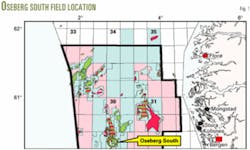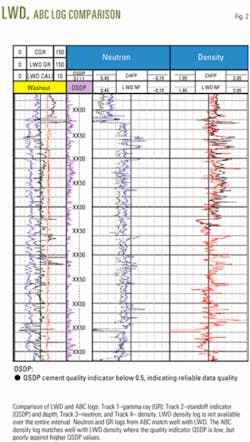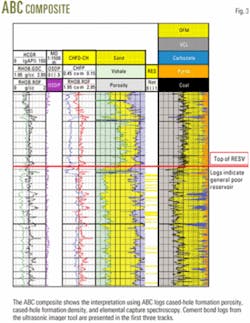The ability to log wells from behind casing is a key addition to available formation evaluation services because it enables operators to assess bypassed zones, analyze time effects on producing intervals, and optimize well costs when well conditions are not suitable for open hole logging.
Norsk Hydro ASA, operator of the Oseberg South field in the Norwegian Sea (Fig. 1), used analysis behind casing (ABC) services from Schlumberger to obtain log data in the T4 sidetrack of the well. Operational problems in the earlier sidetracks T2 and T3 had triggered the decision to run casing and secure the T4 immediately after reaching total depth (TD).
Failures with the logging while drilling tool have prevented acquisition in the open hole of the density log, critical for evaluating this appraisal well. Once the decision was taken to use cased-hole logs, a complete suite was chosen to optimize completions and develop the structure.
Formation evaluation
For many years, openhole formation evaluation has been the standard in reservoir evaluation. Where openhole logging is difficult, innovative tool designs and processing software have made formation evaluation from behind casing an effective option so that cased-hole results can complement or replace LWD logs.
Cased hole services include resistivity, porosity, sonic, bulk density, pulsed neutron, reservoir pressure and reservoir fluid sampling. In addition to wireline methods, there are coiled tubing and downhole tractor methods available for deviated wells and difficult logging conditions.
Logging from behind casing is an additional cost-effective tool for optimizing well construction and reservoir management by providing results of comparable accuracy to openhole data. Cased hole logging services are helping operators to find and evaluate by-passed pay, evaluate the changes over producing zones with time, assess the effectiveness of water floods and other secondary and tertiary recovery programs, update the profiles of wells logged years ago, and even obtain valuable data on old wells that have never been logged.
Case background:Oseberg South field
The Oseberg South field, operated by Norsk Hydro, is 81 mi (130 km) west of the western coast of Norway, on the eastern flank of the Viking graben structure. Oseberg South consists of different structures and the F-21 well was the third well on one of the structures. The reservoirs are of moderate to poor quality and strongly heterogeneous. The Oseberg South well was drilled as a water injector and as an appraisal well for further development of the structure.
Operational problems including unstable borehole, tight-hole, and pack-off problems led to the drilling of sidetracks T2, T3, and T4. Problems encountered in the T2 and T3 boreholes resulted in the decision to case the T4 as soon as it reached TD.
The T4 was drilled at 70° deviation, penetrating the Jurassic Heather sandstone and the Upper and Middle Tarbert formations. Failure of the LWD tool as the T4 was drilled resulted in the premature abandonment of LWD logging and the absence of density log data on 984 ft (300 m) of reservoir rock.
Having already drilled three sidetracks, Norsk Hydro did not wish to keep the hole open for logging in case conditions in the T4 also deteriorated. Instead, Hydro chose to run liner in the T4 immediately after reaching TD and collect the data missing through ABC logging.
ABC logging program
Some types of cased-hole logging tools are sensitive to the quality of the cement bond behind casing. Successful logging typically depends on cement and casing conditions being met, including thickness and position of the casing, and thickness of the cement. These conditions were met in the well and good quality ABC logs could be expected.
The density logs obtained with the cased-hole formation density (CHFD) tool enabled Norsk Hydro to meet its primary requirement for estimating the formation porosity and the volume of shale (Vshale). Slower logging speeds were used in order to improve statistical precision. The density accuracy with the best-assumed conditions was ±0.03 g/cc.
The cased-hole formation porosity (CHFP) tool was added to assess the quality of CHFD log and to compute Vshale. The CHFP tool measures both formation porosity and sigma–with fewer environmental effects than standard chemical-source tools–and thickness of the cement sheath, which is a good quality indicator for the density measurement.
A decision was made to obtain more information on lithology and mineralogy by running the spectral logs, elemental capture spectroscopy (ECS) and hostile natural gamma spectroscopy (HNGS). Gamma ray measurements from spectral logs were used as input for Vshale calculation, and ECS-data to calibrate the Vshale calculation. Logs in the T4 were run with a wireline tractor.
Results of ABC logging
All the ABC logs were acquired as planned. The cement bond logs indicated poor bond quality, but log quality indicators such as standoff from CHFP logs and the expected log response nonetheless indicated good data quality. This suggests conditions for ABC logging improve in a highly deviated well with casing centralized, even when a poor cement bond exists.
ABC density logging filled in the major gap in the LWD data that had resulted from the earlier tool failure. These ABC logs showed a good match with the earlier LWD density logs obtained under open hole conditions. Some density differences between LWD and ABC logs appeared, possibly related to the hole conditions behind casing, However, there is a good correlation in reservoir zones.
Small offset between the LWD and cased-hole neutron data reflects the difference between the physics of measurement (thermal versus epithermal neutron). Fig. 2 shows the comparison of LWD and ABC logs. The logs indicate good repeatability of the measurements. Fig. 3 is a composite log showing cement bond logs with interpretation using ABC logs.
The availability of ABC services meant that in making a prudent choice to secure the T4 hole by running liner as soon as drilling reached TD, Norsk Hydro did not have to sacrifice the opportunity to obtain a full set of logs in the well, as it had planned.
Acknowledgment
The authors thank Mari Skaug, manager of petroleum technology, Norsk Hydro; and Alan Sibbit, advisor for petrophysics, Schlumberger; for their time and efforts in reviewing and editing this article prior to its submission for publication.
Bibliography
For more on reservoir evaluation behind casing: Bellman, K., Bittner, S., Gupta, A., et al., "Evaluating and Monitoring Reservoirs Behind Casing," Oilfield Review 15(2), Summer 2003, pp. 2-9.
The authors
Scott Bittner (bittners1@ slb.com) is product champion for Analysis Behind Casing, Schlumberger Technologies Corp., since April 2003. Between August 2000 and April 2003, he served as testing operations manager for reservoir evaluation wireline and well completions and productivity, Oman, the latest in a series of professional positions in wireline and other organizations during his 16 years with Schlumberger. Bittner holds a BS in mechanical engineering from Carleton University, Ottawa, and is a member of APEGGA.
Badarinadh Vissapagrada ([email protected]) is principal petrophysicist and petrophysics domain champion for Schlumberger Data & Consulting Services, Stavanger, since October 2002. Previously, he was a petrophysicist for Schlumberger in Abu Dhabi, from 1997. Prior to that, he served as E&P manager for Reliance Industries Ltd., Bombay, 1995-97, and held a series of geophysical positions with ONGC from 1982 to 1995. Vissapagrada holds a BSc in physics, mathematics, and chemistry from P.R. College, Kakinada, India, and an MSc in geophysics from Andhra University, Visakhapatnam, India. He is a member of SPWLA, SPE, and SCA.
Beathe Heggen (beathe.heggen @hydro.com) is a petrophysicist for Norsk Hydro ASA, serving in that capacity on the Oseberg South production project since March 2002. For 5 years before that, she worked in various North Sea fields for Baker Hughes INTEQ. Heggen earned a BS and MSc in geology with specialization in quaternary geology in 1997 at the University of Bergen. She is a member of Norsk Geologisk Forening, the Norwegian Geological Society.








